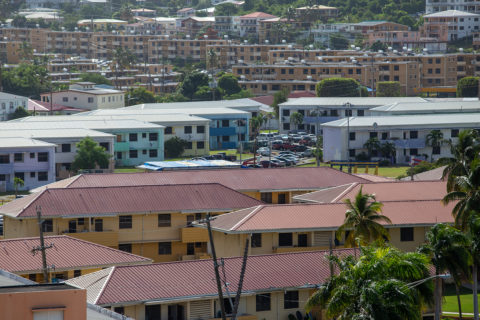St. Thomas Equity & Resiliency Panel
A ULI Advisory Services Panel provided recommendations and strategies for equitable and resilient development in St. Thomas in August of 2019
Location:
St. Thomas, U.S. Virgin IslandsCity / Client:
Virgin Islands Housing AuthorityDate:
August 25-30, 2019Status:
Complete, Report available hereTopics:
Housing
Economic Development
Resilience
Placemaking
MobilityULI Center / Focus Area:
Urban Resilience
During the last two years, ULI has made a strategic effort to bring its expertise to the Caribbean region in response to the devastating 2017 storms that laid bare much of the region, providing strategic advice to St. Croix, Puerto Rico, and now St. Thomas. This panel, which was engaged by the Virgin Islands Housing Authority, Virgin Islands Housing Finance Authority, and Virgin Islands Economic Development Authority, specifically builds upon the work of the 2018 St. Croix ULI Advisory Services panel which provided recommendations on equitable and resilient redevelopment in the Caribbean following the devastating 2017 hurricane season.
This panel was tasked with providing recommendations and direction for St. Thomas to resiliently and equitably build new communities, address affordable housing challenges, and build a sense of place and community.
ULI was asked to consider and provide strategic recommendations on the following areas:
- Helping new communities become more resilient and reduce consumption of natural resources
- Creating an equitable economic development vision for the next 5, 10, and 15 years
- Integrating the existing affordable housing stock into the surrounding neighborhood; and
- Creating a cultural theme and design principles to tie the area together and brand it as a unique location
Learn more about ULI’s other post-hurricane efforts in St. Croix and in Toa Baja, Puerto Rico.

Photo By Laura T Magruder
US and USVI flags fly above the public housing projects in Havensight. Front to back: Lucinda A. Millin senior residence, Paul M. Pearson Garden (multi-colored two-story structures), Oswald E. Harris Court (yellowish buildings at the base of the hill in the right-hand corner).
Panel Experts
Adam Weers, Panel Chair
Trammell Crow Company
Washington, DCNeil Albert
DowntownDC BID
Washington, DCDan Anderton
Dewberry
Germantown, MDAllison Anolik
AECOM
Raleigh, NCR. David Gibbs
Renewable Energy Consultant
Brooklyn, NYMarion Mollegen McFadden
Enterprise Community Partners
Washington, DCTyrone Rachal
Red Rock Global Capital Partners
Atlanta, GA
Panel Recommendations
The panel’s key recommendations fall into four categories: economic development, recovery and resilience, housing, built environment, and governance.
- Economic Development:
Focus on economic development investments at all scales in an effort to achieve greater diversification within the economy. The panel recommends investment in the downtown district paired with enhancements to tourism and small business development. - Recovery and Resilience:
Harness Community Development Block Grant Disaster Recovery (CDBG-DR) funding to jump-start community resilience. Use the opportunity to recognize resilience as a key economic infrastructure and make key shifts in the structuring and delivery of power in St. Thomas. - Housing:
Use CDBG-DR funding as a catalyst for revitalization of public housing and creation of greater cohesion with the surrounding community. Seize the opportunity to revitalize public housing. Focus on creating holistic residences that incorporate retail and community space and focus on social connectivity, access to amenties, and the needs of residents of all ages. - Built Environment, Placemaking, and Mobility:
Improve quality of life through reunifying and connecting surrounding communities by placing residential at the core of the vision. Recognize and celebrate St Thomas’s unique culture by reinforcing built environment concepts and tying themes into placemaking throughout the island. - Governance:
Evaluate structural and governance barriers, implementing reform and ensuring a high level of delivery and implementation in the context of the disaster recovery funding and new administration. Improve coordination among agencies, bolster confidence in leadership, and increase community engagement.
Read more recommendations

Photo By Dan Anderton/ULI
The panel’s vision for the study area makes an effort to use the built environment, placemaking, and mobility enhancement to bridge its six key areas: the Charlotte Amalie Downtown District, Havensight, Millin-Pearson Neighborhood Market, The Oswald Harris Cottage Community, Health Care Hill, and The Nest at Charlotte Amalie
